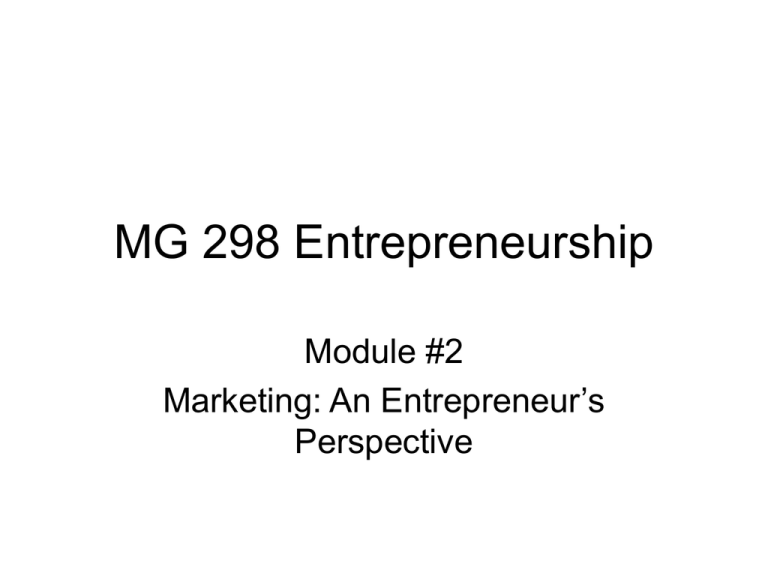MG 298 Entrepreneurship Module 2 Marketing The Entrepreneurs
advertisement

MG 298 Entrepreneurship Module #2 Marketing: An Entrepreneur’s Perspective The Entrepreneurs’ Perspective • In the field of observation, chance favors only the prepared minds. • Louis Pasteur • Building the better mousetrap is a great intellectual achievement; but to make it a great economic achievement, you have to sell some. Perspectives on Marketing • Understanding your offering the way a customer values it – not as an innovation, but as a package of innovative services; • Discerning which kinds of customers are likely to yield the first sale; and which will comprise the large, mainstream market; • Learning what markets are trying to tell you; and responding appropriately. Technology as Service • Transition from technology professional to technology entrepreneur • Replace the techno-centric view of the world with one that is customer-oriented • Technology is not just a tangible object, but rather a package of valuable services • Customers have little use for products as objects; they have great use for services these objects provide. Examples of Technology as Services • Light bulb: nobody buys it as a product; rather for the expectation of illumination at work place, desk, home, etc. • Can we look at a service that pays the customer’s electric bill, and guarantees a quantity (lumens) and quality of light (colour, flicker, etc.) • Similarly, software is not a product residing on the computer; rather, could be resident on a remote file server; Can this form of service delivery provide additional value to customers? The Dimensions of Performance • To understand the markets for technology, we must look at the customer’s perspective of the offering as a package of services. • Some of the service features customers would look for are: speed, convenience, economy, prestige, etc. • Taken together, these performance dimensions define the competitive space Performance Space The Dynamics of Performance • Simple products (pencil, haircut) tend to compete along one or two dimensions. • Complex technology products (aircraft) compete along many more dimensions (e.g. Concorde competed on speed, range payload, and prestige) • The challenge in discerning all dimensions of customer value is to identify the poorly articulated or unspoken components of value Dynamics of Performance • The principal sources of change in the performance valued by customers include: • Customer Limitations: Sometimes, customers are unable to use further improvements along some dimensions. E.g. clock speed of PC’s. Customer value can be built by attention to other dimensions of performance, such as size, cost, energy efficiency, heat dissipation, etc. Dynamics of Performance • Experience: With experience, customers discover which performance dimensions have the greatest value for them; rest are put into the good enough category. • External Events/ Trends: Events and trends outside of the market workings can influence the desired performance: • e.g. Oil supply disruption ►► fuel economy Women in work force ►► convenience in household products and services Dynamics of Performance • Technical Improvements: IT has improved the safety and reliability of many systems, e.g. nuclear plants, banks, insurance, transportation systems, etc. • Lack of Technical Improvements: Technology improvement reaches the limits of physical capabilities, e.g. speed of land vehicles, space of IC circuits, etc. Market Planning: First Sale to Mainstream Market • Nothing builds credibility like sales: boost morale, payroll, revenue, profits, investor confidence. • Build cash and credibility with sales as early in the venture’s growth as possible. • However, these early sales must spring from a well-conceived market plan that focuses resources on the mainstream customers most likely to build the business Market Planning: First Sale to Mainstream Market • Best marketing plans view early sales as having one overriding purpose: to serve as a point of departure for the mainstream market that will become the ultimate source of sustainable growth for your venture • Failure to reach the mainstream market leaves in a state of suspended animation • Analyze technology as a service offering with attendant package of performance dimensions • Discern the tech responsive customers from those not likely to respond to innovative tech Market Planning: Model of Technology Marketing • Understand why some customers adopt new tech innovations, and others don’t. • Can sort potential customers for a new technology into five categories: • Innovators • Early Adopters • Early Majority • Late Majority • Laggards Market Planning: Model of Technology Marketing • Innovators: Actively seek change, sometimes for its own sake. First to turn to new-technology solutions. Technology itself is a core interest for them. Alas, they are a very small minority of your ultimate customers set • Early Adopters: Easily relate to the technology, and comprehend its benefits readily. Less interested in tech for its own sake, than for its ability to solve problems. More in number than Innovators, yet a minority in customer base Market Planning: Model of Technology Marketing • Early Majority: First to make wide-scale use of your technology (comprise ~1/3rd of customer population). Appreciate tech, but only so far as its adoption does not cause undue risk. Demonstrate that the tech works as advertised, so as to reduce their risk perception • Late Majority: Less able to handle new tech with skill, tend to await its becoming an industry standard before adopting; require a lot of support in adopting new tech (comprise ~ 1/3) Market Planning: Model of Technology Marketing • Laggards: Tend to focus on price, and do not adopt new technology unless it is so deeply embedded in a system that it becomes inevitable and invisible. As an entrepreneur, you really should not bother with these customers – life is too short Early Sales Market • First sales from innovators and early adopters • Approach them as the visionaries that they are • Often recognize the social dimensions of a product or process, and purchase it for those values, notwithstanding its economics; e.g. solar photovoltaic panels • Penetrating main stream markets is however a greater challenge, difficulty often being cost • innovators and early adopters add the psychic value of pollution abatement to their cost – no analogous value proposition for mainstream How to Swim in the Mainstream • Transition to mainstream markets the most difficult challenge of high-technology marketing • Markets cannot be understood entirely in economic terms: recognizable set of actual or potential customers with similar needs and values • Mainstream markets characterized by participants referencing each other in making buying decisions, risk tolerance is lower, and the opinions of experienced peers valued • Early majority customers do not talk to the innovators and early adopters; so need an ab initio marketing strategy for these mainstream customers Mainstream Marketing • Operating characteristics of the Normandy invasion: • Establish the beachhead; • Stabilize your foothold; and • Break out to capture the market territory How to Swim in the Mainstream • Most technology companies begin with a beachhead in the new market- a niche that is underserved, but relevant as its customers are mainstream customers • Beachhead will command resources entirely out of proportion to the sales it will generate • Ignored by the sales-driven business; important for the market-driven business How to Swim in the Mainstream • Basic offering may have to be revised as you consider how the performance dimensions of your product appear to these customers, especially what kind of support services they will require to adopt the technology • Establish a critical mass of customers in the mainstream market, who will serve as references • Invest scarce marketing resources in a few strategic niches in the mainstream market Some Additional Marketing Considerations • Just as the market territory is new to you; so is your offering new to the market • In the case of breakthrough products, customers simply might not understand the utility of your offering or know-how; • Beginning marketing plan should emphasize education over sales – a notion called concept marketing Price Considerations • Price is more than just a number • Effective pricing strategy helps gain more customers; also prevents losing the ones you already have • Technology is making pricing more difficult than ever- e.g. Internet shifts control of transactions for many goods and services to the customers • As price becomes the determining issue in purchasing decisions, the tendency towards commoditization of your product is accelerated Entrepreneurial Pricing Strategies • Base your price on the value of your offering to the customer, rather than on your cost to produce • Be willing to assume the risk of novel pricing strategies, such as offering separate prices for unbundled services; • Use these novel strategies proactively, without waiting for competitors to initiate the pricing action; and • Remain flexible in pricing, allowing variances in both the offering (s) and the price (s), based on the market segment and the price elasticity Marketing as Learning • Marketing wisdom begins with understanding your offering as a packaging of services • It ends with understanding the value function of the customer – the package of services that people actually want to use in work and living • Learn to analyze customers and markets from their own framework and logic, rather than forcing them to respond to your framework and logic. This is called organizational learning Managing the Learning Process • New ventures launched from a corporate platform can use the contacts and learning process (es) of the parent company • For an independent start-up, systematic contacts with key constituent groups, not involving transactions, must be built. • One way to accomplish this is through a Board of Advisors. Select persons of independence and broad knowledge, and offer compensation through a small equity stake Marketing as the Key to Successful Entrepreneurship • Build your marketing organization around open-minded people, with a capacity to shed assumptions, when the evidence of the market-place requires it. • Successful entrepreneurship is a marketdriven process. So we must understand the salient characteristics of the technology market-place.








